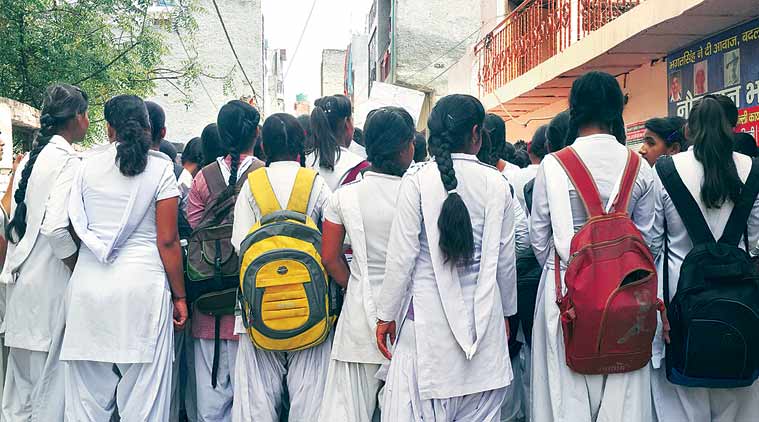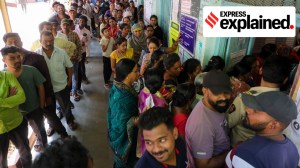- India
- International
The state of affairs at New Delhi’s most crowded government school
Over 1,500 students who failed in the exams are back in their old classrooms, further increasing the numbers in those sections: over 150 students each in the 14 sections for Class IX and XI.
 Girls protest outside Karawal Nagar school. (Photo: Ankita Dwivedi Johri)
Girls protest outside Karawal Nagar school. (Photo: Ankita Dwivedi Johri)
“Half-an-hour into the exam, it started raining. We had to run to the corridors, hold our answer sheets against the wall and respond to the questions. By the time I submitted my answer sheet, it was all smudged, nothing was legible.”
That was on March 18 and this Class XI student was appearing for her political science exam at the school courtyard because there was no space in the classroom. On March 31, when the results were declared, the 16-year-old, like 700 students in her class, had failed — just 300 had passed.
Welcome to the Government Girls Senior Secondary School in Karawal Nagar, Delhi’s most crowded government school, where 7,000 students are accommodated in four shifts, each class has 14 sections, six subjects are covered in three-hour classes, and where most classes are conducted outdoors because the 69 classrooms are just not enough.
Not surprisingly, the results for Class IX were no different. Out of the 1,100 students, 213 students or just 20 per cent had been promoted to the next class, leaving 887 behind. Last year for the same classes, approximately 50 per cent students had passed.
[related-post]
So why did over 1,500 students from two senior classes in the girls’ school fail to make the cut in these two crucial school years? And why did at least 600 of them, along with their parents, stage a protest at the school after the results were declared, damaging property, breaking flower pots and even allegedly pelting stones at a police team?

“There is no place for students to read or study,” said Lal Mohan, whose daughter failed in Class XI. “Even the library has become a staff room,” he said.
Said Suresh Chandra, a school management committee member, “In the three-hour shifts, classes are taken for just about two hours, and even in those hours there are no teachers. In some subjects there have been no teachers for the entire session. How is a student expected to cover six subjects in this time and with such poor resources?”
Said the parent of a student, who did not wish to be identified, “Most parents whose children study here earn less than Rs 10,000 a month. We can’t afford to put our children in private schools. Some of the students here can’t even read a word of Hindi despite studying it for years.” The students are charged a fee of Rs 60 a month.
Principal Mala Rani, who was accused by the protesting students and parents of being “inaccessible”, acknowledges their concerns but asserts that the school has always been “upfront” about its limited resources.
“They (parents) know from the beginning that their children will have to take some classes sitting outside. We have been pushing for better infrastructure, but look at the numbers that we are dealing with. We have about 18 permanent teachers and as many as 116 guest faculty members. The pressure on the permanent teachers is immense. Many of the guest teachers miss classes and take leave, too,” she added.
Teachers blame students
Teachers at the school also point to “poor preparation” by students. “The curriculum in Class IX and XI is quite tough. Some of these students can’t even write complete sentences, how do we mark those answers? The adjoining boys’ school has about 45 permanent teachers, that could be one of the reasons for better results there,” said a Class XI teacher.
The boys’ school has 4,500 students and about 10-12 failed in each section of Class IX and XI this year. In 2015, the Class XII board result for the boys’ wing was 88.20 per cent and 68.77 per cent for the girls.
When contacted, Delhi Education Minister Manish Sisodia told The Indian Express: “The average number of students in government schools in the capital is about 1,000 to 1,500. In the border areas, where students come from the NCR region, the numbers can go up to 3,000 students. The Karawal Nagar school is in the northeast part of the city and has a number of students from Ghaziabad, etc. The sheer scale makes things difficult to handle.”
Given the conditions, a senior Department of Education officer said, the poor results did not come as a surprise. “After the first-term exams in September, about 10 per cent had passed in classes IX and XI. These marks also carry weight in the final assessment. Because of the no-detention policy, most of the students managed to make it past Class VIII, but Class IX and XI have tougher subjects,” said the official.
‘Move to reduce numbers’
Some parents see the recent failure rate as a move to “reduce numbers” in the classes. “They cannot fail anyone till Class VIII, so they want to force students to withdraw from the school by failing them. This is the school’s way of reducing the large number of enrolled students. My daughter has failed in two subjects, but she has been failed for the entire year. They should have at least put her in the compartment list and allowed her to take a re-exam,” said another parent of a Class XI student.
“We are aware of the large number of failures and the answer sheets were re-checked. But a majority number of students had submitted blank sheets. What marks do you give for that,” said the education officer.
The dismal results this year aside, the school’s problems run deeper. “Last year, we were assured that the school has got permission to build an additional 58-room building with four floors, but we haven’t heard anything on that yet. Over 90 students sit in classrooms meant for 40-45 children,” said Suresh Chandra.
“The appointment process of guest teachers begins in July and by the time they start teaching it is almost September, six months of the session are already wasted by then. Some schools don’t have teachers even till January-February,” said Supreme Court Advocate and education activist Khagesh Jha.
So what options do the students have now? “We have suggested to parents that they enroll their children in Patrachar Vidyalayas (correspondence education for drop-outs, 10th-pass and 11th-fail, under Directorate of Education). The burden on the present classrooms has also increased,” said the education department official.
For now, the over 1,500 students who failed in the exams are back in their old classrooms, further increasing the numbers in those sections: over 150 students each in the 14 sections for Class IX and XI. And once again, the courtyard is their classroom.
May 14: Latest News
- 01
- 02
- 03
- 04
- 05




































